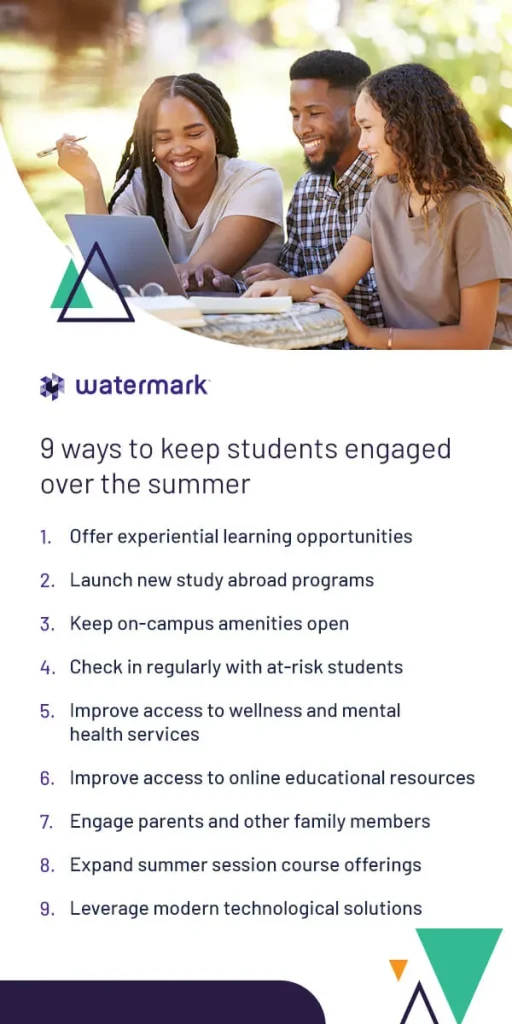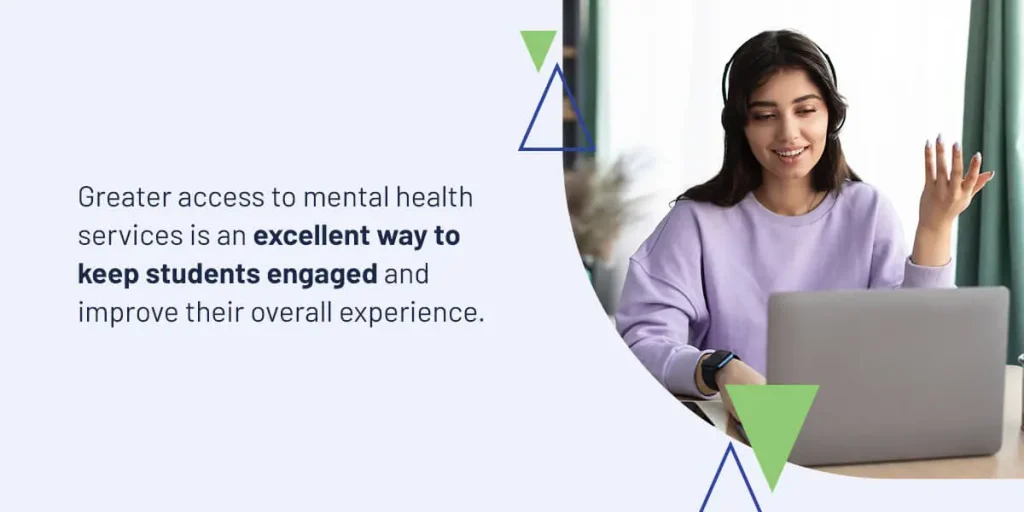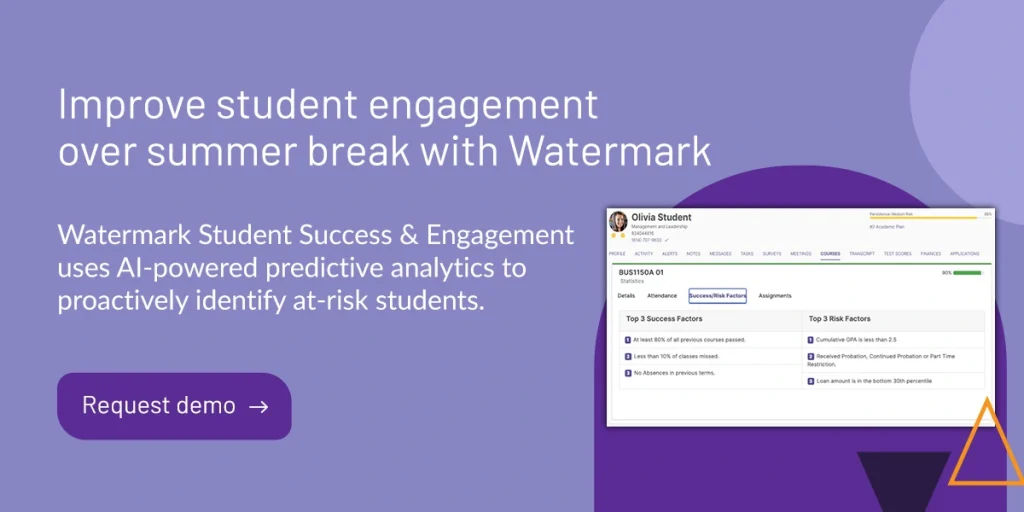




Summer vacation gives students a chance to rest, recover from the academic year, and spend valuable time with family and friends. But amid all the sunshine, fun vacations, and summer jobs, students can lose touch with their institutions — which can make it harder to come back strong for the fall session.
While keeping students engaged over the summer can be challenging, it’s essential for helping them achieve their academic and career goals. Taking a proactive approach can help you boost engagement and student success rates even when class is not in session.
In the months they spend away from campus, students are more likely to disengage from their education. The consequences of this disengagement include summer learning loss, also known as “summer slide,” and student attrition, or “summer melt.”

“Summer slide” refers to the phenomenon of students forgetting what they’ve learned over the summer months.
Although researchers have only studied the issue in K-12 students thus far, and variations in research methodologies cast doubt on its existence, it’s still true that many students struggle to adjust to the new term. The issue seems to disproportionately affect minority and low-income students, which may play a role in the higher education equity gap.
To bring these students back on track, instructors may need to spend additional time at the beginning of the fall semester revisiting concepts students should have mastered in the spring. This extra instruction cuts into the valuable time they have to teach the rest of the course material, which can negatively impact learning outcomes.
“Summer melt” refers to when enrolled students quietly drop out and “melt away” over summer vacation. Although the term most often describes incoming freshmen who leave before their first semester, it can also refer to current students who choose not to continue their education.
Some of the most common contributing factors to summer melt include:
Engaging these at-risk students over the summer can help prevent attrition by keeping them connected and informed.
Staying connected with your students is critical for minimizing summer slide and student attrition. These strategies can help you boost student engagement over any long academic break, including summer vacation.

Experiential learning programs like community-based learning courses, internships, co-ops, and independent research projects give students the opportunity to apply what they learned in the classroom to the real world.
Students who take advantage of these opportunities over the summer can benefit from:
Additionally, offering these opportunities during the summer can help make these courses more accessible to students with busy schedules.
Mini study abroad programs are another potential option, as summer break is the perfect time for many students to take advantage of these opportunities. Without their typical campus obligations filling up their calendars, students have more availability to pursue travel opportunities.
When students are unsure how their lessons relate to the world outside the classroom, they’re more likely to become disengaged and apathetic. Studying abroad allows students to apply their learning in real life, which can help them feel more connected to their program.
It can also help them expand their worldview by exposing them to people from different cultures and life experiences, which aligns with higher ed’s mission to promote diversity, equity, and inclusion. If there’s any extra room in the financial aid budget, you could offer scholarship opportunities for these programs to ensure everyone who wants to participate has a fair chance.
Dining halls, residence halls, medical facilities, and other campus amenities either reduce their hours or completely close down at the end of the academic year. For students who are experiencing housing or food insecurity, or who need special accommodations, a lack of access can create additional challenges.
International students, for example, may need to continue living in campus housing over the break. Qualifying students experiencing food insecurity may need to eat in your dining halls.
However, keeping campus services fully open when demand is low can cost your institution more than necessary in energy and other utility bills. Running analytics on your student data can help inform your approach to summer amenities by helping you predict the number of students who will be using campus services at any given time.
Students who are struggling during the school year often continue to struggle over the summer, which can lead them to question whether they should continue their education.
That’s where a team of dedicated student success coaches comes in. These professionals can work with at-risk students to develop solutions tailored to their unique situations, thus minimizing the risk of students dropping out or transferring to other institutions.
The behavioral and assessment data your institution already collects during the school year is an asset here, as you can use it to identify which students are most at risk of dropping out. With this insight, your student success team can strategize how and when to approach each student on the list.
Additionally, an integrated communication system makes it possible for student success coaches to check up on students throughout the break to ensure they’re still on track. Some potential options include:
Investing in the right solution can help make communication accessible to all students, further improving your engagement strategy.
Today’s college-age students are facing a mental health crisis, which can escalate during the summer while they’re away from campus. Poor mental well-being has a serious impact on student retention rates — a recent National Student Clearinghouse study revealed that 25% of students who showed symptoms of mental health issues dropped out.
According to the latest Healthy Minds survey, which examined student mental health across 133 institutions during the 2021-22 academic year, record numbers of students reported symptoms of:
Those issues don’t go away when students leave for the summer and may even worsen for students experiencing poverty, homelessness, family turmoil, and other challenges.
Adapting your institution’s mental health and wellness services can help students cope with these issues so they can stay engaged with their education. Some examples of possible solutions include:

Greater access to mental health services is an excellent way to keep students engaged and improve their overall experience.
Many students want to brush up on their knowledge before the start of the new semester to get ahead or to explore new concepts they may not have covered in class. When students are away from campus for the summer, their access to learning materials and other campus resources becomes restricted.
While the library is usually the first place students look for books, journals, and archived periodicals, many institutions and departments lag behind in digitizing materials for online access. As a result, students who live far from campus must wait until the fall semester or check their local libraries for the resources they want — which can cause them to lose interest and disengage while they wait.
Supporting digitization initiatives can help these students gain access to the materials they need to continue learning throughout the summer, helping them stay engaged without needing to visit campus or spend large sums of money on books they do not need for class.
Digitizing rare or special collections materials, such as rare books and microfilm, can also help preserve these items by eliminating the need to access them in person. With fewer students handling these materials, your institution can more easily maintain them for many years to come.
When students have a strong support system behind them, they’re significantly more likely to perform well at your institution. Part of creating that system involves bringing close family members such as parents and grandparents into the loop.
Engaged parents encourage their students to continue their educational journeys, potentially boosting retention rates and student performance.
One of the easiest ways to engage parents is by sharing important student data such as:
Additionally, reminding parents of important deadlines and upcoming events can help them hold their students accountable for completing the administrative tasks required to remain enrolled in your institution. And personalized messaging using data analytics tools helps increase the chances of parents reading your communications.
Students lead busy lives, especially if they pursue higher education later in life. While institutions know that work and family responsibilities prevent many students from attending daytime classes during the week, few offer evening or weekend alternatives — and these students often feel forced to choose between taking asynchronous online courses or giving up on their education.
Although summer sessions are significantly shorter than a typical semester, they can give nontraditional and working students more flexibility in balancing work, family, and school.
Summer sessions can also present faculty with an excellent opportunity to commit to continuous improvement. During the summer, professors can work with populations of students they might not have in class during the regular school year, which can help them develop their teaching methods for maximum educational impact.
Data is one of the most useful assets your institution can use to connect with students. It can inform your strategy in deciding which actions to take, which may include:
All of the above actions can help your institution continuously improve its approach to boosting college student engagement over summer break, from finding new opportunities for course offerings to determining whether a faculty member is an effective teacher.
That said, the right tools are essential for harnessing the full power of your data. Investing in robust educational technologies (edtech), such as an integrated student success software platform, may be what you need to start making data-driven decisions about student engagement.
For example, a software tool with predictive analytics uses artificial intelligence (AI) algorithms to identify trends in historical data and utilize those insights to predict future outcomes.
While keeping students engaged when they’re not on campus can be a challenge, having the right tools at your disposal will help you boost student retention and reduce the risk of summer slide.
Watermark Student Success & Engagement, our intelligent student success software solution, uses predictive analytics to proactively identify at-risk students and automatically notify student support team members so they can intervene.
Seamless integrations with all Watermark solutions as well as leading LMS and student information systems (SIS) ensure efficient data transfer for rapid, on-demand analysis and reporting.
Request your personalized demo today to see Student Success & Engagement in action.


























































































































































































































































































































































































Submit this form to schedule a meeting with one of our reps to learn more about our solutions. If you need customer support instead, click here.